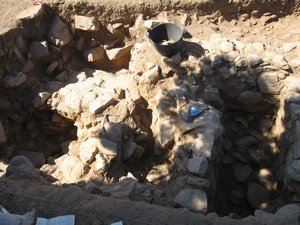Advertisement

 Trench 4400
Trench 4400
Ryan's Late Minoan steps are featured in the upper left-hand-corner of this picture, and Kristen's Late Minoan closest is visible in the lower right-hand-corner of the photo.It took a few days to get rolling, but taking over as supervisor (or, Pitt-Boss, as the undergrads I have been working with prefer to call me), of trench 4400 has been entirely worth it. At first, however, I was totally and completely lost. Last Monday morning, at 6:45 AM, I found myself flipping through the trench notebook, and being completely baffled as to what was going on-- elevation measurements were off, loci recordings were all out of wack, and no one was really sure what they were supposed to be doing. About fifteen minutes later, when the previous "trench supervisor" arrived on site he made the assuring comment "I'm glad you're taking over the trench today Jeff, because I'm afraid I might've 'fallen asleep at the wheel' a bit in terms of keeping the notebook..." A great way to start the week... but I'm getting ahead of myself. Let me quickly explain the "science" of archaeology-- that is, the methods of excavation and recording that allow us to actually build a picture of the past by literally disassembling ancient remains:
Rule #1: Any archaeological layer (including architectural features and artifacts) came before the levels above, and after the levels beneath. 
 The Dumpy Level
The Dumpy Level
The dumpy level, sitting on the tripod in the distance, provides a level-sight to measure elevations from. Using a measurement from a known elevation point, we are able to extrapolate the elevations of different levels and artifacts in the trenches.This is basic stratigraphy. A professor once told me to think about it like building a house...the first layers of that house (the foundation) are the first things to be put in place, and the roof, the highest part of the house is the last thing to be put up. A similar principle holds true for archaeology, since Late Minoan builders (1600-1200 BC)-- for the most part-- will build their houses, etc. on top of Middle Minoan and Early Minoan ruins. In order to account for this, we establish an arbitrary locus (plural loci, Latin for a location, or "spot") with a distinct number for any archaeological area we are digging, including architectural features such as floors or walls. We then dig these loci in 10 to 40 centimeter "passes" where we remove an arbitrary amount of soil or debris, basing the depth of the pass on the type of soil/debris we're digging through, and the changes that we detect in the soil as we're digging. In any given loci we might dig 1 or 2, or 4, 5 or more horizontal passes, taking elevations (using a "dumpy level," and an elevation stadia rod- the dumpy is basically a telescopic

 A Late Minoan Amphora
A Late Minoan Amphora
After nearly a week of excavations in the "closet" (and more than enough second guessing about whether we'd every find anything significant) Kristen discovered this nearly intact Late Minoan amphora, giving us hope that there was more to come...lens with a bubble level that allows us to measure elevations of objects, floors, loci, etc. from a given elevation point using a level sight). As we dig we're constantly establishing new loci when we come down on new soil or depositional layers, or architecture (which allow us to "locate" the artifacts and architecture along the horizontal and vertical plane).
Rule #2: Any artifact or archaeological feature found in a given sealed layer was placed there at roughly the same time. "Hordes", "Deposits", "Floors", and "Destruction levels" all provide examples. These are "sealed" deposits, meaning that the archaeological layers above the deposit is intact and allows us to feel confident that the deposit in question hasn't been disturbed. The objects from these similar archaeological contexts( and thus similar elevation levels) must have been deposited before the layer above was laid down, and after the layer below was laid down, thus making them roughly concurrent. By recording the types of pottery that are found in the same deposits, and their chronological relation to each other (i.e. Late Minoan IA conical cups come before Late Minoan IB ledge-rim cups, and after Middle Minoan IIA type cups) we can create a

 Everything's under control...I'm a professional...
Everything's under control...I'm a professional...
After using nearly a liter of lighter-fluid, we got the charcoal going...relative chronology, and thus date different layers in different trenches across the site and establish what layers on site are from the same period.
Rule #3: There are no do-overs. Archaeology is all about slowly dismantling, and eventually destroying the evidence. By excavating we are removing artifacts and destroying architecture in order to gain knowledge. Because of this careful recording is imperative Photographs, sketch drawings, daily journals and trench recording sheets for elevation levels, artifacts, architecture, etc. (which collectively make up what we call a "trench notebook") are tremendously important. By taking good notes, photographs and making sketch drawings, we attempt to convey the relationships between objects and architecture in the ground. Without careful recording archaeology is simply treasure hunting-- of course we love to find gold, bronze, and beautiful ceramics, but archaeology is much more concerned with reconstructing the lives of ancient people, and less interested in just finding beautiful stuff (though, of course, we like that too...)
So, to return to the trench...my trench notebook, elevations, photos and drawings were all over the place, labels were confused, and I was very confused. But, four days later, after I had spent three afternoons sorting out what
photographs related to which levels, what the proper elevations for various loci were, and where certain objects were located when they were excavated, it suddenly all became worth it. In the south-eastern corner of my trench, Ryan (a UNC-G student) started to unearth a series of Late Minoan steps (in all we excavated 6, and they probably extend further to the south of our trench...too bad there's a HUGE 12 foot high, 30 foot wide dump pile there and we won't be moving it to create a new trench further to the south to follow the steps...). The stairs are very nicely constructed, and potentially represent an uphill pedestrian street that climbed up the east side of the island. That was Thursday morning...then after lunch of Thursday, Kristen (another UNC-G student), who was digging in the western side of the trench, in between three nicely built stone walls (probably in a storage closet), came down on a nearly intact Late Minoan storage amphora (SPOILER ALERT: A week later to the day, Kristen and I are still excavating in the Late Minoan "closet" and we're still finding tons of pottery, stone tools, cups, plates, cooking pots...about a 40 centimeter deposit, and

 I meant to do that...
I meant to do that...
Everything's under control...I swear.still going... but more on this for next week). Other trenches had found an Early Minoan floor deposit with beautiful ceramics and tableware, and some very nice Hellenistic deposits of pottery. Needless to say, on Friday afternoon we left our trench content that we could enjoy Independence Day weekend knowing we had had a productive week.
Somehow in all the excitement towards the end of last week, I had agreed to be the "grill-master" for the July 4th party Tom Brogan was throwing on Saturday (funded entirely by the center). Tom felt that it would be good for our "kephi,"which is Greek for "spirit" or "esteem." So, Saturday evening, about 8PM, I started a charcoal grill out behind Georgous's taverna, and prepared to cook 50 hamburgers, 35 hot dogs and 25 bratwurst, which would be accompanied by deviled-eggs, potato salad, Sea-Breezes, Baked Beans, and Apple and Cherry pie, all made by different members of the excavation or employees at the Kentro. I was surprised to find out that we were going to be cooking over "real" charcoal-- not Kingston Brickettes coated in lighter fluid-- but real pieces of honest-to-God charcoal wood that had been baked (cooked? prepared? not sure

 Spinalonga Island
Spinalonga Island
First occupied by the Venetians in the 13th century, Spinalonga's fortifications held off the Turks for nearly 40 years. The island then served as a leper colony at the beginning of the 20th century.what the right word is here) just a few towns away in Myrsine (Mir-see-nee). So, in good American fashion, I used about a liter of lighter fluid to finally get the charcoal hot...and then spent the night drinking Corona's and Budweiser's (which, believe it or not, are considered a rare treat here in Greece) and manning the grill. It was a great party, and a few of the other local excavation projects (who are associated with the INSTAP center) came by for food and fun. The highlight of the night: Doug, the 42 year-old INSTAP Architect and Artist, who grew up in the US, quieted everyone down so we could listen to Jimi Hendrix's rendition of the Star-Spangled Banner from Woodstock.
On Sunday, after a late start, due in large part to a long Saturday night, I figured I needed to take advantage of having a rental car as much as possible, gathered together four friends, and headed north along the coast to the Venetian island fortress at Spinalonga. It's an amazing place, especially since this fortress, which was built and controlled by the Venetians when they occupied Crete from the 14th-17th centuries, held out against the Turkish invasion

 The Bastion
The Bastion
25-30 feet thick at places, no wonder it took 40 years to take the fortress.for 40 years longer than any other Venetian settlement on the island. It's quite a fortress, not only located on a large island, but also with some serious defensive walls (some of the bastion have walls 25 or 30 feet thick!). It was a nice day trip, and we stopped at the small city of Aghios Nikolaos (St. Nicholas) for dinner and drinks that evening. It was a nice, low-key way to close out the weekend.
As I write tonight (again my apologies for writing nearly a week later than promised...) I only have about a week left in Crete. I leave Mochlos next Friday, stopping in Athens for a night to see the new Acropolis Museum, and then arriving in the US on Sunday. At the same time seven-weeks both seems like such a long time to have been away from home, but also too short of a time to have been in Crete. There's so many things I wish I had more time to see for before I leave... Crete has really grown on me-- a beautiful place, friendly people, and some fascinating archaeology. I definitely plan on making it back.
I hope all is well back

 Venetian Grafitti
Venetian Grafitti
A Christian cross still is engraved in the highest part of the fortress, probably from Venetian times... in the US and that you all had a happy, safe and enjoyable 4th. Looking forward to seeing many of you soon--
Until next week, be well,
Jeff
Advertisement
Tot: 0.122s; Tpl: 0.012s; cc: 13; qc: 49; dbt: 0.0463s; 1; m:domysql w:travelblog (10.17.0.13); sld: 1;
; mem: 1.2mb








